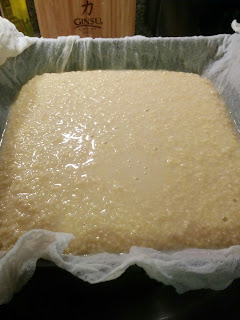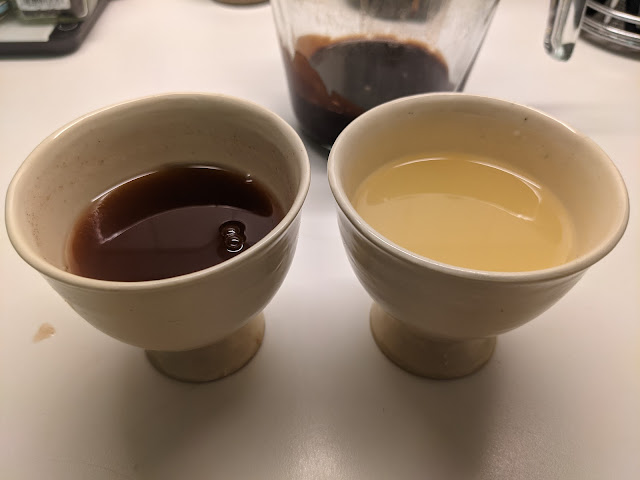Pressing and Straining
Chinese grain wines are fermented on the mash, which means that if you want to get something drinkable out the other end, you need to separate the grain from the liquor.
Rice wines so far have had much more sediment that's mysteriously immune to gravity's inexorable pull.
This is in the recipe for YE4W1, 神麴酒方:A method for making wine using exceptional yeast cakes. Most recipes don't specify pressing but I think it's implied.
The editor's note is a little wrong. In scroll 8, there are a number of recipes for making vinegar which start by making wine. A few of them mention the text included above, which is "a method for pressing wine: press it out through a hair/wool bag."
We also have this line from YE3W2, a short-wine, about processing the yeast starter culture:
Which mentions a two-step process. This is what I think we can tell so far:
I spent some time reading Science and Civilisation in China, Volume 5, Part 9, Textile Technology: Spinning and Reeling hoping to get some insight into wool use, but it doesn't mention wool at all.
The Qimin Yaoshu does mention sheep rearing, and wool handling, though. It specifically mentions felt production, but has no other discussion of woolen fabrics. This fits with my understanding that wool in China was not really raised, but that there was a small amount of exchange with herding people to the north, and the Qimin Yaoshu is from enough of a border region to include that kind of information. There are also recipes for cheese!
In the wool section, it talks mostly about "white sheep," and then talks about "black sheep" which need to be sheared later in the season. There's an annotation in the text which follows. I don't know when or who the annotation is from, but it's all we have right now:
This doesn't make a lot of sense on its face until you realize that 羊 means both sheep and goats. I think they're talking about mohair. I got to feel a sample of a coarse-woven mohair fabric and I think it would do the initial filtering well.
As for the second stage of filtering, I have yet to get my hands on the right kind of silk. I tried using nylon bags that modern brewers use to strain out grain, with little success: they are not fine enough to catch the tiny particles polluting my rice wine. They might be a good initial filter, though, since they seemed to clog less than the cheesecloth.
To do: get some mohair fabric, or fibers and sweet-talk some spinners and weavers into making it into fabric, and to get some tabby-woven silk that's dense enough to filter well.
I initially was assuming this was happening without firm evidence, because the fermented mash is not wine by any means.
 |
| Blorp |
I've used cheesecloth with some success to filter it, but it's a little difficult because you have to squeeze it pretty hard to get the wine out, or else sensuously massage the bag of mash with your hands to allow it to continue draining. I think that it's hard to drain because the grain particles are pretty fine, and clog up the filter. Beer mashes can run into this problem occasionally, but don't usually because they're less porridge-like since the grain isn't cooked.
Straining through cheesecloth has been what I've been doing, but you still end up with a lot of sediment coming out of the bag.
Some of this sediment will settle out, particularly from millet wines, but not all of it, so you have to either decant carefully or deal with the sediment, which changes the flavor profoundly. It's also why I poured pancake batter at Pennsic last year.
It does clear out in millet wines, though:
 |
| I suppose this is why it's called "yellow wine" |
But! I've discovered some more evidence in the Qimin Yaoshu.
酒若熟矣,押出,清澄。
|
When the wine seems finished, press it out [using a bamboo screen over a trough, and a board], and decant it so that it is clear [ed. note: scroll 8 “如壓酒法,毛袋壓出” has more information on pressing].
|
This is in the recipe for YE4W1, 神麴酒方:A method for making wine using exceptional yeast cakes. Most recipes don't specify pressing but I think it's implied.
The editor's note is a little wrong. In scroll 8, there are a number of recipes for making vinegar which start by making wine. A few of them mention the text included above, which is "a method for pressing wine: press it out through a hair/wool bag."
We also have this line from YE3W2, a short-wine, about processing the yeast starter culture:
以毛袋漉去麴滓,又以絹濾麴汁於甕中,即酘飯。
|
Take a wool bag [described in scroll six, under “raising sheep,” called a 毛堪酒袋] and use it to strain out the yeast cake sediment, and then additionally filter it using juan [plain, tabby-woven silk], and put the liquor into the weng, and then add the rice.
|
Which mentions a two-step process. This is what I think we can tell so far:
- It's reasonable to assume that most wine was pressed through a hair/wool bag or something equivalent. You don't really get wine otherwise.
- Even pressing that way doesn't get you clear wine, as my experience has shown.
- Using a second stage filter of silk is documentable for the starter culture, and is probably a place to start for filtering finished wines.
I spent some time reading Science and Civilisation in China, Volume 5, Part 9, Textile Technology: Spinning and Reeling hoping to get some insight into wool use, but it doesn't mention wool at all.
The Qimin Yaoshu does mention sheep rearing, and wool handling, though. It specifically mentions felt production, but has no other discussion of woolen fabrics. This fits with my understanding that wool in China was not really raised, but that there was a small amount of exchange with herding people to the north, and the Qimin Yaoshu is from enough of a border region to include that kind of information. There are also recipes for cheese!
In the wool section, it talks mostly about "white sheep," and then talks about "black sheep" which need to be sheared later in the season. There's an annotation in the text which follows. I don't know when or who the annotation is from, but it's all we have right now:
毛堪酒袋,兼繩索之利:其潤益又過白羊
|
[black sheep] hair is suited for wine sacks, and when doubly-plied [as rough yarn?] has this benefit: it is much sleeker than white sheep[‘s wool].
|
This doesn't make a lot of sense on its face until you realize that 羊 means both sheep and goats. I think they're talking about mohair. I got to feel a sample of a coarse-woven mohair fabric and I think it would do the initial filtering well.
As for the second stage of filtering, I have yet to get my hands on the right kind of silk. I tried using nylon bags that modern brewers use to strain out grain, with little success: they are not fine enough to catch the tiny particles polluting my rice wine. They might be a good initial filter, though, since they seemed to clog less than the cheesecloth.
To do: get some mohair fabric, or fibers and sweet-talk some spinners and weavers into making it into fabric, and to get some tabby-woven silk that's dense enough to filter well.
This work is licensed under a Creative Commons Attribution-ShareAlike 4.0 International License.




I have some silk at home that you can try - what we call china silk is tabby woven and dense, but light weight.
ReplyDelete